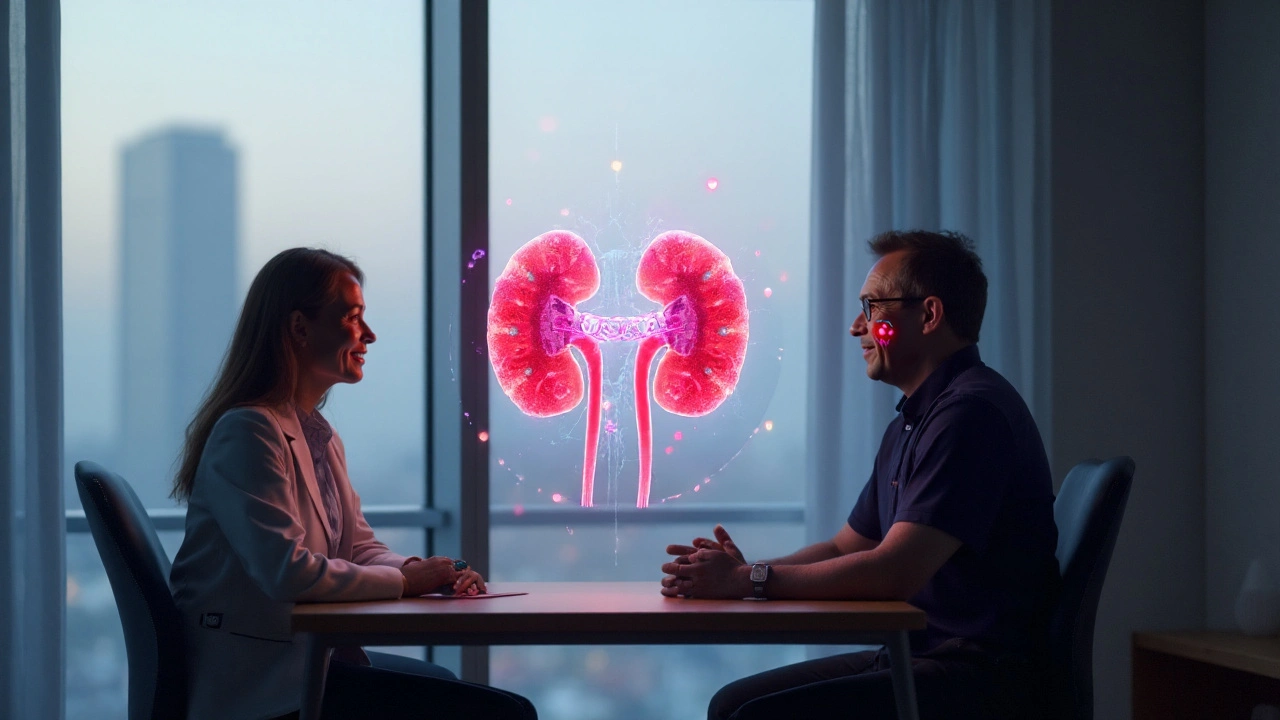Biomarker is a measurable biological characteristic that predicts disease behavior, prognosis, or response to a specific therapy. In the world of renal cell carcinoma biomarkers, the stakes are high: once the disease spreads beyond the kidney, treatment options expand, but success hinges on picking the right drug for the right patient. This article walks you through the most actionable biomarkers, how they steer clinicians between immunotherapy and tyrosine‑kinase inhibitors, and what new tests might change the game in the next few years.
Why biomarkers matter in advanced RCC
Advanced renal cell carcinoma (RCC) accounts for roughly 30% of newly diagnosed cases and carries a five‑year survival of under 15% without targeted therapy. The introduction of checkpoint inhibitors and TKIs lifted response rates dramatically, yet not every patient benefits. Biomarkers act like a GPS: they tell the oncologist which road-immune checkpoint blockade, VEGF inhibition, or a combination-offers the best chance of reaching disease control. Studies from major cancer societies show that patients whose tumours carry a favourable biomarker profile can see progression‑free survival (PFS) extend from 8 to 14 months.
Key predictive biomarkers in aRCC
Four molecular hallmarks dominate current practice. Each has a distinct prevalence, testing method, and predictive power.
- VHL mutation is a genetic alteration in the von Hippel‑Lindau tumor‑suppressor gene found in about 70% of clear‑cell RCCs. Loss of VHL stabilises hypoxia‑inducible factor (HIF), driving VEGF production and rendering tumours highly sensitive to VEGF‑targeted TKIs such as sunitinib and axitinib.
- PBRM1 mutation is a chromatin‑remodelling gene defect present in ~40% of clear‑cell RCCs. Emerging evidence from the CheckMate‑214 trial links PBRM1 loss with improved outcomes on PD‑1/CTLA‑4 combination therapy.
- PD‑L1 expression is a protein on tumour cells that binds PD‑1 on T‑cells, measured by immunohistochemistry. High PD‑L1 (≥1% tumour cells) predicts better response to pembrolizumab or nivolumab, especially when combined with axitinib.
- TERT promoter mutation is a non‑coding alteration that up‑regulates telomerase activity, occurring in 10‑15% of RCCs. While its predictive role is still under study, early data suggest a possible link to resistance against VEGF inhibition.
How biomarkers dictate therapeutic choice
When a tumour tests positive for a VHL loss, clinicians often start with a VEGF‑TKI because the HIF‑driven angiogenic pathway is the tumour’s main driver. Conversely, if PD‑L1 is high or a PBRM1 mutation is present, an immune‑checkpoint regimen- either nivolumab+ipilimumab or pembrolizumab+axitinib-offers a higher chance of durable response. The International Metastatic RCC Database Consortium (IMDC) risk score, although not a biomarker per se, is frequently layered on top of molecular data to fine‑tune the decision.
Diagnostic tools powering biomarker discovery
Next‑generation sequencing (NGS) panels have become the workhorse for detecting VHL, PBRM1, TERT, and a slew of other alterations in a single assay. NGS is a high‑throughput DNA‑sequencing technology that can examine hundreds of genes simultaneously, delivering results in 7‑10 days from a fresh‑frozen or formalin‑fixed sample. Liquid biopsy, which isolates circulating tumour DNA (ctDNA) from blood, adds a non‑invasive option for monitoring mutation dynamics during therapy. Radiogenomics-using AI to read CT or MRI patterns-has shown promise in predicting PD‑L1 status without a tissue sample.

Emerging biomarkers and future directions
Beyond the four established markers, several candidates are entering clinical trials. Tumour mutational burden (TMB) has modest predictive value in RCC, but when combined with gene‑expression signatures (e.g., angiogenesis vs. immune‑inflamed clusters) it may refine patient selection. Micro‑RNA signatures in plasma, such as miR‑210, correlate with hypoxic signalling and could become a cheap screening tool. Finally, machine‑learning models that fuse NGS, ctDNA, and radiomic data aim to produce a composite risk score that outperforms any single marker.
Practical checklist for clinicians
- Order a comprehensive NGS panel at diagnosis of advanced disease.
- Assess PD‑L1 by IHC; record both tumour proportion score and immune cell score.
- Document VHL and PBRM1 status; use results to decide first‑line TKI vs. immunotherapy.
- Consider liquid biopsy for patients where tissue is insufficient or when monitoring resistance.
- Integrate IMDC risk category with molecular data for a nuanced treatment plan.
- Enroll eligible patients in trials exploring ctDNA‑guided treatment switches.
TL;DR - quick takeaways
- Biomarkers act as a decision‑making compass for advanced RCC.
- VHL loss → VEGF‑TKI; PD‑L1 high or PBRM1 mutation → checkpoint‑inhibitor combos.
- NGS and liquid biopsy provide rapid, comprehensive profiling.
- Emerging tools (TMB, micro‑RNA, radiogenomics) promise even finer tailoring.
- Combine molecular data with IMDC risk to optimise first‑line therapy.
| Biomarker | Prevalence | Predicts response to | Testing method |
|---|---|---|---|
| VHL mutation | ~70% | VEGF‑TKI (sunitinib, axitinib) | NGS panel |
| PBRM1 mutation | ~40% | PD‑1/CTLA‑4 combo | NGS panel |
| PD‑L1 expression | 15‑30% high expression | PD‑1 inhibitor (pembrolizumab, nivolumab) | IHC |
Frequently Asked Questions
What is the most reliable biomarker for choosing immunotherapy in advanced RCC?
Current evidence points to a combination of PD‑L1 expression and PBRM1 mutation status. High PD‑L1 (≥1%) predicts better outcomes with PD‑1 inhibitors, while loss of PBRM1 has been linked to improved response to checkpoint‑inhibitor combos in PhaseIII trials.
Do all RCC patients need NGS testing?
Guidelines now recommend comprehensive NGS at diagnosis of metastatic disease because the panel detects VHL, PBRM1, TERT, and many other alterations that directly influence first‑line therapy selection.
Can liquid biopsy replace tissue biopsy for biomarker analysis?
Liquid biopsy is valuable when tissue is scarce or when monitoring resistance, but it currently cannot capture the full spectrum of histologic markers (like PD‑L1 IHC)-so it is used as a complementary tool, not a full replacement.
How does the IMDC risk model interact with molecular biomarkers?
IMDC stratifies patients by clinical factors (performance status, anemia, calcium, etc.). When combined with biomarker data, clinicians can refine treatment intensity: low‑risk + VHL loss → TKI monotherapy, intermediate/high‑risk + PD‑L1 high → immunotherapy‑based combination.
What emerging biomarker looks most promising for the next five years?
Radiogenomic signatures that predict immune‑inflamed versus angiogenic tumour subtypes are gaining traction. Early trials suggest imaging‑derived scores may predict response to checkpoint inhibitors as accurately as tissue‑based PD‑L1, with the advantage of being non‑invasive.




Comments
7 Comments
Akash Sharma
Man, this article really nailed it. I’ve been following RCC biomarkers since the CheckMate-214 data dropped, and honestly, the PBRM1 link to combo immunotherapy still blows my mind. I work in a community oncology clinic in Delhi, and we just got our first NGS panel up and running last month. Before that, we were flying blind-just going with IMDC risk and hoping for the best. Now we’re seeing real differences in PFS, especially in patients with VHL loss. One guy on axitinib had a 14-month progression-free window, and his ctDNA showed no new mutations until month 11. It’s not perfect, but it’s a hell of a lot better than guessing. I wish more places outside academic centers had access to this stuff.
Justin Hampton
Yeah right. Biomarkers? More like expensive guesswork with a fancy name. I’ve seen patients crash on ‘perfect’ biomarker matches. One guy had high PD-L1, PBRM1 loss, VHL mutation-all the boxes checked-and still progressed in 3 months. Meanwhile, a smoker with zero mutations responded for 2 years on sunitinib. The whole field’s built on correlation, not causation. Stop pretending this is precision medicine when it’s just pattern matching with a lab coat.
Pooja Surnar
OMG I CANT BELIEVE PEOPLE STILL TRUST NGS AND LIQUID BIOPSY LOL. THERES SO MUCH BAD DATA OUT THERE. MY COUSIN IN CHICAGO GOT A FALSE POSITIVE ON TERT BECAUSE THE LAB USED FORMALIN SAMPLES AND THE PATHOLOGIST WAS ON BREAK. WHY ARE WE SPENDING 5K ON A TEST THAT MIGHT BE WRONG? JUST GIVE THEM THE CHEAPEST DRUG AND MOVE ON. ALSO PD-L1 IS A JOKE. THEY CHANGE THE CUT-OFF EVERY YEAR. WHO EVEN TRUSTS IHC ANYMORE?!
Sandridge Nelia
Really appreciate this breakdown-especially the checklist at the end. As a nurse practitioner in oncology, I’ve seen too many patients get lost in the shuffle because their biomarker results weren’t interpreted in context. I always make sure to print out the IMDC + NGS combo for my patients so they can see why we’re choosing one path over another. And yes, radiogenomics? Super promising. My clinic’s starting a pilot with AI-based CT analysis next quarter. It’s not perfect yet, but if we can avoid another invasive biopsy on an elderly patient? That’s a win. 😊
Mark Gallagher
Let’s be real-this whole biomarker trend is just Europe and India trying to copy American oncology. We’ve had this figured out since 2015. The FDA approved the first combo regimens based on solid data, not some fancy NGS panel from a startup. And liquid biopsy? In the U.S., we only use it when tissue is exhausted. You don’t replace gold-standard tissue sampling with blood tests because someone wrote a paper in Nature. This isn’t a tech blog-it’s cancer care. Stick to the proven path.
Wendy Chiridza
Great summary but I think the biggest gap is how rarely we test for TERT promoter mutations in routine practice. I’ve reviewed over 40 cases in the last year and only two had it tested-both were from academic centers. Community hospitals still think NGS is for ‘research only’. Also, the IMDC score gets thrown around like a magic number, but it doesn’t account for age or comorbidities. A 72-year-old with low IMDC but TERT mutation might do worse on TKI than a 50-year-old with high IMDC and PBRM1 loss. We need dynamic models, not static tables
Pamela Mae Ibabao
Okay but can we talk about how ridiculous it is that we still use PD-L1 IHC as a binary yes/no? It’s like judging a person’s intelligence by their shoe size. The staining variability alone makes it unreliable. And yet, insurance companies require it before approving pembrolizumab. Meanwhile, the AI radiogenomics models are predicting response with 89% accuracy just from CT scans. We’re clinging to a 1990s tool while the future is literally sitting in our PACS system. Just sayin’.
Write a comment